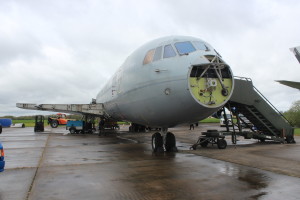Simon Hale watches as a Queen finds a new home.
She was dubbed the Queen of the Skies and regarded as the best of British design and engineering – and now she is to have a permanent home in the West Midlands.
For the last Vickers VC10 flying anywhere in the world will be making its final journey, by road, on June 21st to be put on display at the Royal Air Force Museum Cosford.
The iconic aircraft, celebrated for achieving the fastest crossing of the Atlantic prior to the supersonic Concorde and for its elegance in the livery of BOAC (later British Airways), was the first commercial jetliner to have its engines – four Rolls Royce Conways – located at the tail behind all the passengers.
The museum’s new aircraft, serial number XR808, was part of an initial order from the RAF to Vickers/BAC at Brooklands, Surrey in 1961 for five VC10s for VIP use and Far East routes. Taking speed and range to new levels, the plane had clocked up a staggering 43,650 flying hours in almost fifty years by the time that it was retired in 2013 as the RAF’s oldest remaining VC10.
Having served worldwide as a troop and weapon carrier with No 10 Squadron from RAF Fairford and later Brize Norton, XR808 was modified to provide an air-to-air refuelling and passenger role in 1996. After it was transferred to No 101 Squadron in 2006, the aircraft played a role in the Afghanistan War providing support for a joint Czech Republic and UK exercise during Operation Rhino – a raid by US Army Rangers on several Taliban targets.
The aircraft is now being prepared for its final move to Cosford at Bruntingthorpe Airfield in Leicestershire, and we were given the opportunity to see work in progress.
Like a giant incomplete Airfix model, the aircraft had had its tail piece, outer wings and front section removed, with the rear fuselage, inner wings and main undercarriage still to be dismantled. The main fuselage will then be carried on a low-loader lorry along the M69 and M6, bordering Coleshill , Erdington and Great Barr as it passes through Greater Birmingham.
The dismantling process has been carried out over the past seven months by a team of eight engineers from GJD Services, a specialist maintenance and aircraft salvage company based at Bruntingthorpe.
For Gary Spoors, GJD’s Accountable/Engineering Manager, the project has fond significance because the VC10 was the first aircraft he flew on; he also worked on it during his RAF career. “Preserving our aviation heritage is important to me and I am extremely proud to have been given the opportunity to be part of this project,” he said.
“We at GJD have been given a fantastic opportunity to demonstrate our engineering skills and abilities during the dismantling and the eventual rebuilding process of XR808.”
Ian Thirsk, Head of Collections at the RAF Museum, added: “This is a unique aircraft and it would not be possible to accurately portray the history of the RAF without an example of the type. Therefore it is essential that such a pivotal and long-serving plane is preserved by the RAF Museum.”
For more information about Royal Air Force Museum Cosford, click on www.rafmuseum.org or call 01902 376200. The museum is open daily from 10am and entrance is free of charge.



